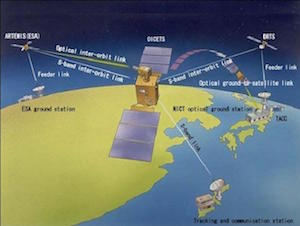Difference between revisions of "OICETS"
Jump to navigation
Jump to search
Ehillstrom (talk | contribs) (Created page with "OICETS (Optical Interorbit Communications Engineering Test Satellite), or Kirari, was a JAXA mission begun in 1993 and launched in 2005. The satellite was a 570 kg payload des...") |
Ehillstrom (talk | contribs) |
||
| (One intermediate revision by one other user not shown) | |||
| Line 1: | Line 1: | ||
| + | [[File:OICETS.jpeg|frame|right|Communications schematic for the OICETS mission]] | ||
OICETS (Optical Interorbit Communications Engineering Test Satellite), or Kirari, was a JAXA mission begun in 1993 and launched in 2005. The satellite was a 570 kg payload designed to test interorbit links (space to space links between satellites in different orbits). It established an optical link between itself and ESA’s [[ARTEMIS]] as well two additional space-to-space S-band links. | OICETS (Optical Interorbit Communications Engineering Test Satellite), or Kirari, was a JAXA mission begun in 1993 and launched in 2005. The satellite was a 570 kg payload designed to test interorbit links (space to space links between satellites in different orbits). It established an optical link between itself and ESA’s [[ARTEMIS]] as well two additional space-to-space S-band links. | ||
More information on SPOT-4 can be found on the Earth Observation Mission website [https://directory.eoportal.org/web/eoportal/satellite-missions/o/oicets]. | More information on SPOT-4 can be found on the Earth Observation Mission website [https://directory.eoportal.org/web/eoportal/satellite-missions/o/oicets]. | ||
| + | |||
| + | [[Category:Optical Communications]] | ||
Latest revision as of 21:11, 4 December 2015
OICETS (Optical Interorbit Communications Engineering Test Satellite), or Kirari, was a JAXA mission begun in 1993 and launched in 2005. The satellite was a 570 kg payload designed to test interorbit links (space to space links between satellites in different orbits). It established an optical link between itself and ESA’s ARTEMIS as well two additional space-to-space S-band links.
More information on SPOT-4 can be found on the Earth Observation Mission website [1].
